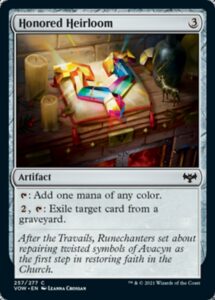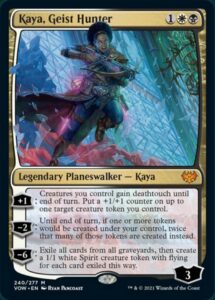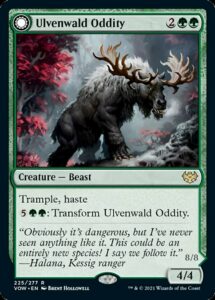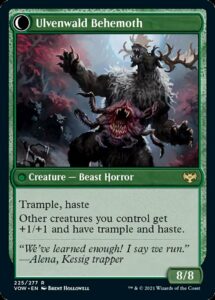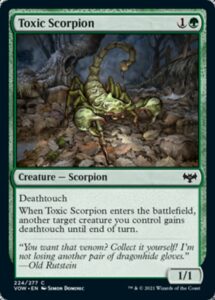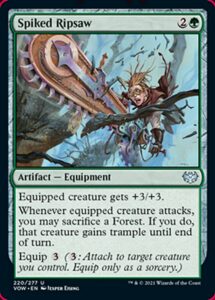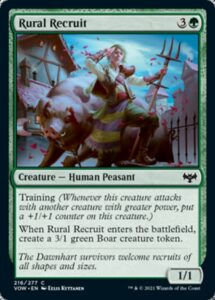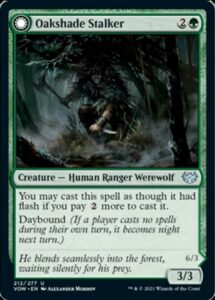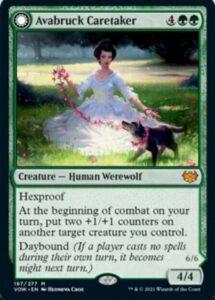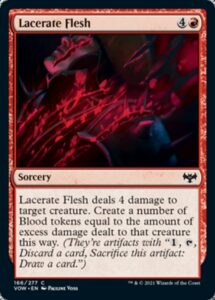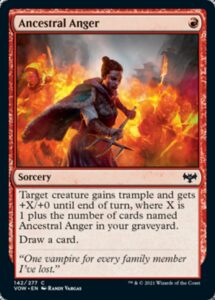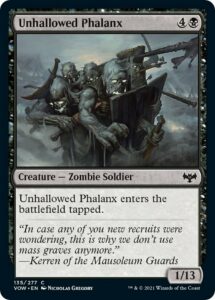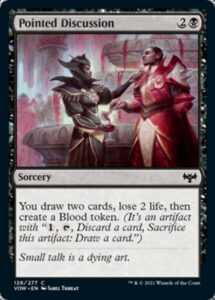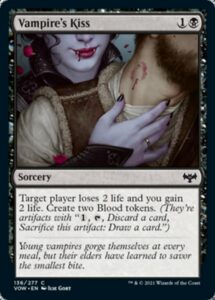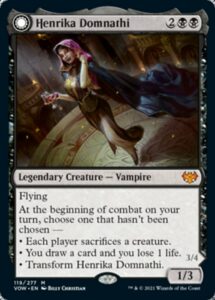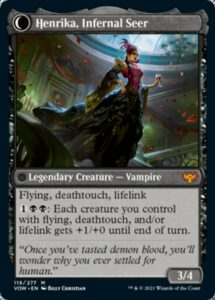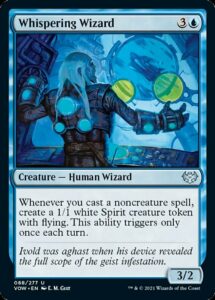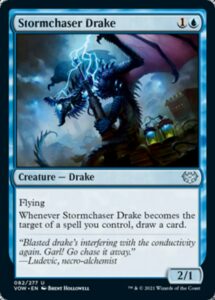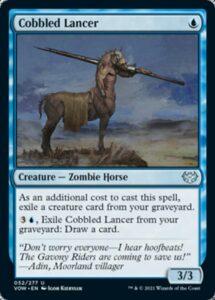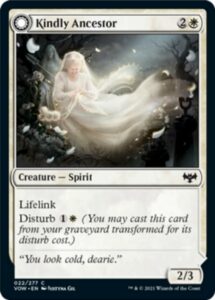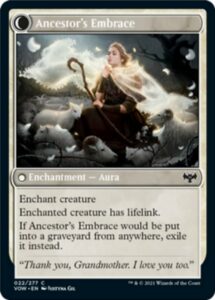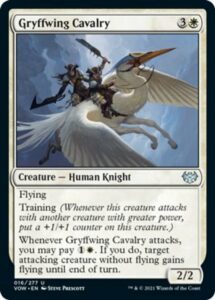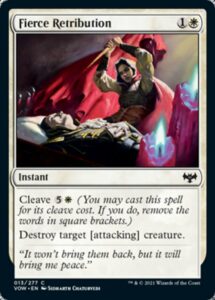After a brief week of previews, Crimson Vow releases in two days. Last week, we reviewed the set’s new and returning mechanics. Today, we’ll go in far closer, reviewing individual designs of a smattering of Crimson Vow cards. The set runs the gamut from novel designs to familiar, from exciting cards to those garnering more muted enthusiasm. We’ll cover all of that, and as a treat, we’re going to start backwards, starting with colorless spells and ending at white.
Colorless & Multicolor
It’s been no secret that Manalith has room for a bit of extra power (though it’d be far too powerful at two mana, just like Cancel). Honored Heirloom provides a bit of extra value by switching from mana production to incidental graveyard hate. That’s a welcome tool to have in a graveyard set. At the same time, a graveyard set with overpowered graveyard hate runs the risk of having its primary themes negated (which is part of what happened to werewolves in Innistrad: Midnight Hunt), so the weak rate here is smart design.
This card gets bonus points for being a callback to Vessel of Endless Rest, a similar design way back in Avacyn Restored. Naturally, this is a restored symbol of Avacyn which is just an adorable tidbit of flavor. This also should play better than the Vessel, since the Vessel usually came down too early for the graveyard interaction to matter (granted, it also was in a set with minimal graveyard mechanics, so it rarely mattered).
I’m torn on Kaya, Geist Hunter. Mechanically, this feels solid. It’s a tightly-focused, niche planeswalker, not the type of generically good and flexible planeswalker liable to dominate in Constructed formats. In the right deck, her +1 generates immediate (though minor) value, her -2 generates an explosion of value, and her -6 summons an army that can win the game but also be interacted with. And if your token strategy doesn’t come together in Limited, she can still give your attacking creatures Deathtouch.
On the thematic side, I’m less enthusiastic. Her card’s name is in tension with her effect—she doesn’t hunt down geists, she creates geist infestations. Moreover, this card reminds me a bit of Liliana of the Dark Realms, as it seems rather disconnected from Kaya’s power suite and themes. Kaya has the power to become intangible and the skills of an assassin/hunter/tracker. She tends to take things out herself, not summon an army.
Every one of her planeswalker cards exiles cards from the battlefield (though her original incarnation brings them back). This doesn’t do that, making me wonder what her core mechanical themes are supposed to be. Kaya creating spirit tokens does have precedent with both Kaya the Inexorable and Kaya’s Guile, and it does make narrative sense to make spirits given that she leads the Orzhov Syndicate, but the overall design feels like it could easily have been a new character. I’m glad that Kaya is getting featured more in the story, but I wish this card felt more like what I understand her to be about.
Green
Ulvenwald Oddity is a callback to Emrakul’s presence on Innistrad as well as Eldritch Moon’s werewolf mechanic. I love the simplicity of this callback, as well as how it compares to Questing Beast.
This is a neat little design innovation. Typhoid Rats is fine on its own, but sometimes we get two mana versions with mild upside like Ruin Rat and Rancid Rats. This time, the twist is temporarily sharing the creature’s ability—we’ve seen that before with Flying, but rarely with other abilities. It feels like an obvious design that only seemed obvious once Ikoria introduced keyword counters.
Magic has been pushing the boundaries of its technology for quite some time. Having a chainsaw on a gothic world feels wrong for the time period but right for the horror tropes. Granted, that’s absolutely a nitpick—Magic introduced Rocket Launcher in 1993.
We’ll see how this plays, but it’s definitely not my first guess of how a chainsaw would bolster a creature. It just feels weird that a chainsaw massively bolsters your ability to absorb damage—then again, chainsaws and survivability have gone hand in hand in Army of Darkness.
I love how this card presents a simple quest that can make players, especially newer players, feel smart. Use boar to Train human. But the flavor of learning from a sickle-wielding boar? It’s just adorable (if a tad violent).
This is quite the mechanical callback. Invasion has a cycle of spells (most famously Rout) with this same ability. It’s nice seeing old innovations return in new ways, especially with how well this effect works on werewolves. Oakshade Stalker uses the affordance of its Daybound side while in your hand even at Night, which is a sneaky way to give both sides Flash.
This is a dangerous design. It’s almost certainly going to be fine outside of Limited, since Hexproof’s biggest offenses are on cheap creatures, not Autumn Willow. But it is surprising seeing Hexproof on this and not Ward. At least its ability to give your whole team Hexproof can be shut off by your opponent.
Red
Remember how Ikoria introduced Flame Spill, the black border version of Super-Duper Death Ray? Now we get another innovation in excess damage: it has Bloodlink! The naming here is perfect. Of course excess damage generates blood—you’ve carved through the flesh!
Oakshade Stalker isn’t the only one-off callback to old mechanics. Ancestral Anger harkens back to 1997’s Kindle (which got a whole cycle in 2001’s Odyssey). The design here is clean, aspirational, and inexpensive. You’re not getting anything special until the third Ancestral Anger, but the cantripping makes the cost of playing it seem so low. I can’t say whether this card is strong, but that doesn’t matter. This card is sweet.
Black
A nice way to spice up a Limited format is by creating open-ended cards with obvious quests. On its own, Unhallowed Phalanx boasts a massive set of stats but doesn’t do anything other than block well. But in conjunction with cards like Ancient Lumberknot, Catapult Captain, or Geralf, Visionary Stitcher, it quickly becomes far more than the sum of its (multitudinous) parts.
It’s definitely weird seeing these two cards in the same set. They definitely serve differently purposes—Pointed Discussion is a value generator and Vampire’s Kiss is an aggro/Blood combo card that creates card disadvantage—but their effects read very similarly. I won’t be surprised if a few people cast Vampire’s Kiss thinking it’s Pointed Discussion and wondering where their cards are. I know that Wizards intentionally put both of these into the set, which suggests to me that Blood really needs both for the support, but it nevertheless feels odd.
I love this design. Not only is Henrika a callback to Vampire Nighthawk, one of the most iconic and simple vampires in Magic, but she’s got this great risk/reward mechanic. You can all but guarantee you get a super Vampire Nighthawk immediately—but if you just wait one turn cycle, you can also get a card. And if you just wait one more turn, you can get in a free Innocent Blood. It’s a great skill tester, but with every option providing value, she should be fun to play with even when she’s not optimized.
Blue
One of Magic’s most recent innovations is abilities capped at one trigger per turn. This allows white to gain abilities necessary for Commander without breaking other Constructed formats. It also allows abilities to have cleaner formatting by avoiding end step or upkeep triggers. Plus, it allows more aggressive costing for cards with strong triggered abilities.
All that said, after years and years of getting cards like Young Pyromancer, after seeing just how underpowered Murmuring Mystic is relative to its exciting effect, Whispering Wizard doesn’t excite me much. The ceiling isn’t that much lower, but it’s easy to see that it’s lower. Plus a 3/2 dies to everything.
Triton Fortune Hunter had quite the glow up. Stormchaser Drake feels a bit random in Innistrad, more likely a plant for synergies with a future set than a core part of the environment. It does have synergy with Disturb auras, though card advantage is a strange reward for a mechanic that itself generates card advantage.
The scale of the artwork also is weird. This monster looks massive. If you told me this was an alternate artwork for Iymrith, Desert Doom, I’d believe you. I like the design, but it definitely stands out in not the best way.
I love that we get a single original Innistrad Skaab. I also love getting cheap, aggressive blue creatures with hoops to jump through. The extra ability definitely feels like squeezing a tiny bit of value onto an already juiced card (with a massive drawback), but I’m not complaining.
White
Dinosaur Hunter returns! This type of design is a great way to both spotlight and (weakly) answer a major set theme. We don’t actually see many cards with conditional deathtouch, which makes me wonder what circumstances will lead us to seeing the next iteration.
I love everything about this card. I love how it’s a beautiful, self-contained story. I love how Kindly Ancestor is playable on its own and Ancestor’s Embrace is gravy that can nevertheless swing the game by itself. I love how clean the design is! I love that it’s a card about love!
Midnight Hunt worked hard to make both sides of its Disturb creatures feel connected. Here, the design is so much simpler: you get creature with abilities on one side, and an aura granting the same abilities on the other.
It’s been a bit since we’ve seen a Pegasus Courser or Trusted Pegasus. They were generally too strong at common, so Roc Charger upshifted in rarity and retemplated its ability for much cleaner digital play. It’s nice seeing that design return.
Here, Training makes the card have an even higher ceiling, but its increased mana cost and ability cost slow it down to make snowballing less likely.
This is a perfectly clean split card. Neither side is especially strong, but you’ll happily play them together. It does feel a bit odd that the spell is clearly showcasing Cleaved the text. Yes, Cleave is a flavorless keyword and this could show either version, but stabbing someone in their sleep might not be the ideal image here.
And that’s where we’ll leave it for today. Come Thursday, we’ll have a new format to play on Arena and Magic Online. On Friday, those of us with a safe place to play can gather in person and experience the joy of slinging spells with friends. I hope you have an incredibly fun time with Crimson Vow and that we all enjoy Blood rummaging and casting [parts] of our spells.
And, as always, thanks for reading.
Zachary Barash is a New York City-based game designer and the commissioner of Team Draft League. He designs for Kingdom Death: Monster, has a Game Design MFA from the NYU Game Center, and does freelance game design. When the stars align, he streams Magic (but the stars align way less often than he’d like).

